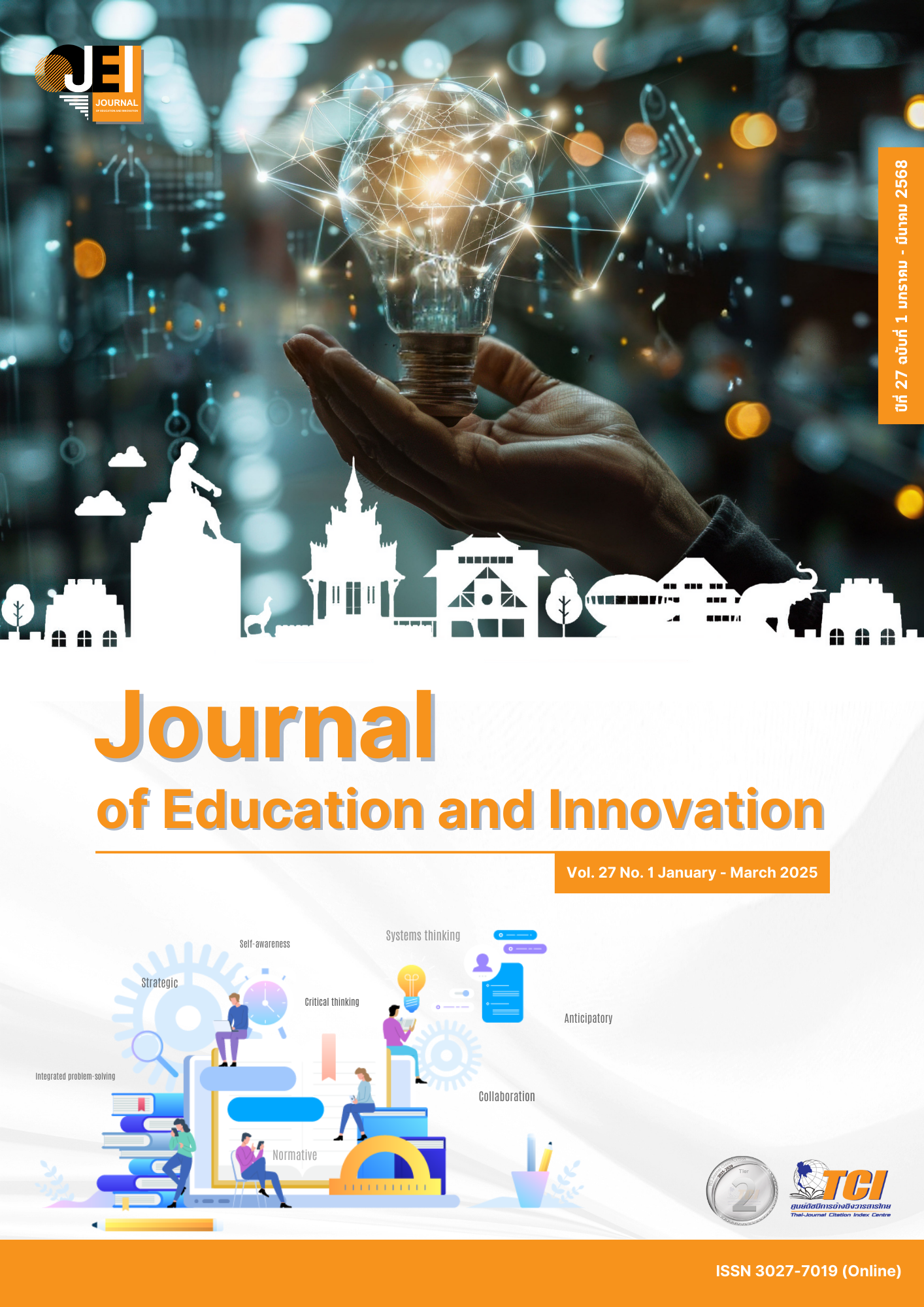รูปแบบความสัมพันธ์โครงสร้างเชิงสาเหตุของปัจจัยที่มีอิทธิพลต่อประสิทธิผลของ โรงเรียนมัธยมศึกษา สังกัดสำนักงานเขตพื้นที่การศึกษามัธยมศึกษา ในภาคตะวันออกเฉียงเหนือ
Main Article Content
บทคัดย่อ
การวิจัยครั้งนี้มีวัตถุประสงค์ 3 ประการ คือ 1) เพื่อศึกษาประสิทธิผลของโรงเรียนมัธยมศึกษาและปัจจัยที่มีอิทธิพลต่อประสิทธิผลในเขตสำนักงานเขตพื้นที่การศึกษามัธยมศึกษา ภาคตะวันออกเฉียงเหนือ
2) เพื่อตรวจสอบความสอดคล้องของโมเดลความสัมพันธ์เชิงสาเหตุที่พัฒนาขึ้นกับข้อมูลเชิงประจักษ์ และ 3) เพื่อศึกษาอิทธิพลทางตรง ทางอ้อม และรวมของปัจจัยที่มีผลต่อประสิทธิผลของโรงเรียน กลุ่มตัวอย่างประกอบด้วยผู้อำนวยการโรงเรียนจำนวน 572 คน คำนวณโดยโปรแกรม G*Power3 และสุ่มอย่างง่าย ตามสัดส่วนของจำนวนประชากรแต่ละโรงเรียน โดยใช้วิธีจับสลาก วิจัยในครั้งนี้ พบว่า 1) ประสิทธิผลโรงเรียนมัธยมศึกษา และปัจจัยปัจจัยที่มีอิทธิพลต่อประสิทธิผลโรงเรียนมัธยมศึกษา โดยภาพรวมมีค่าเฉลี่ยระดับมาก 2) รูปแบบปัจจัยที่มีอิทธิพลต่อประสิทธิผลโรงเรียนระดับมัธยมศึกษาสอดคล้องกับข้อมูลเชิงประจักษ์ 3) ค่าอิทธิพลทางตรง เรียงตามลำดับดังนี้ ด้านปัจจัยศักยภาพของครูผู้สอน (0.45), ด้านปัจจัยบรรยากาศภายใน (0.41), ด้านปัจจัยภาวะผู้นำของผู้บริหาร (0.01), ด้านปัจจัยวัฒนธรรมในองค์กร (0.01) ค่าอิทธิพลทางอ้อม เรียงตามลำดับดังนี้ ด้านปัจจัยภาวะผู้นำของผู้บริหาร (0.71), ด้านปัจจัยศักยภาพของครูผู้สอน (0.14), ด้านปัจจัยวัฒนธรรมในองค์กร (0.13), ด้านปัจจัยบรรยากาศภายใน (0.08) และค่าอิทธิพลรวม เรียงตามลำดับดังนี้ ด้านปัจจัยภาวะผู้นำของผู้บริหาร (0.72), ด้านปัจจัยบรรยากาศภายใน (0.58), ด้านปัจจัยศักยภาพของครูผู้สอน (0.49), ด้านปัจจัยวัฒนธรรมในองค์กร (0.15)
Article Details

This work is licensed under a Creative Commons Attribution-NonCommercial-NoDerivatives 4.0 International License.
เจ้าของบทความมิได้คัดลอก หรือละเมิดลิขสิทธิ์ของผู้ใด หากเกิดการละเมิดลิขสิทธิ์ ไม่ว่าวิธีใด หรือการฟ้องร้องไม่ว่ากรณีใด ๆ ที่อาจเกิดขึ้นได้ กองบรรณาธิการวารสารศึกษาศาสตร์ ไม่มีส่วนเกี่ยวข้องทั้งสิ้น ให้เป็นสิทธิ์ของเจ้าของบทความที่จะดำเนินการ
References
Alig-Mielcarek, M. J. (2003). A Model of School Success: Instructional Leadership, Academic Press, and Student Achievement (Doctoral dissertation). The Ohio State University.
Blanford, S. (2006). Middle Leadership in schools. London: Pearson Longman.
Chareonwongsak, K. (2017). Globalization-based Education: A Case Study of Harvard Education Management. Retrieved from http://drdancando.com
Glatthorn, A. A. (1990). Supervision leadership: Introduction to instructional supervision. Glenview: Scott Foresman.
Hanman, T., & Freeman, J. (2004). Obstacles to comparative studies in new perspectives on organizational effectiveness. San Francisco: Jossey-Bass.
Howell, D. C. (2010). Statistical methods for psychology (7th ed.). Belmont: Wadsworth, Cengage Learning.
Hoy, W. K., & Miskel, C. G. (2008). Educational Administration: Theory, Research, and Practice (6th ed.). New York: McGraw-Hill.
Jaikonkaew, A., Wongsirasawat, C., & Charoontham, O. (2019). Development of an Effectiveness Model for Secondary Schools under the Office of the Basic Education Commission. Journal of Humanities and Social Sciences, 13(2), 551-565.
Klongkhlaew, R. (2018). Development of an Effective Educational Management Model for Private Secondary Schools under the Office of the Private Education Commission in the Eastern Region (Master thesis). Chonburi: Burapha University.
Ministry of Education. (2008). Master Plan for Dream Schools Project. Bangkok: Rungruang Intergroup.
Mott, P. E. (1972). The characteristics of effective organizations. New York: Harper & Row.
Office of the Education Council. (2020). Thai Educational Competency on the International Stage 2020 (IMD 2020). Bangkok: 21 Century Company.
Pefianco. (2009). 21st century skills: Learning for life in our times. San Francisco, CA: Jossey-Bass.
Phanpumpo, N, Thongnut, S., & Ngamkanok, S. (2018). Factors Affecting Success in School Management of Schools under the Office of the Secondary Educational Service Area 7. Educational Research Journal, 13(1), 81-96.
Phokaphanich, W. (2019). Causal Relationship Model of Factors Affecting the Effectiveness of Educational Management in Secondary Schools in the Northeastern Region (Doctoral dissertation). Sakon Nakhon: Sakon Nakhon Rajabhat University.
Premsawas, T., & Chottsukan, S. (2015). Secondary School Culture Model for the Office of the Basic Education commission. Thonburi University Academic Journal, 9(19), 94-107.
Sergiovani, T. J., & Starratt, R. J. (1988). Supervision: Human Perspectives. New York: McGraw-Hill.
Sinlarat, P., & Meesan, N. (2017). Teacher Identity and the Development of Professional Teachers. Bangkok: Chulalongkorn University Press.
Srisa-ard, B. (2010). Basic Research (5th ed.). Bangkok: Suwiriyasan.
Wantaphong, T., Poomphanthu, S., & Phonyiam, R. (2016). Administrators’ competency factors affecting the efficiency of school-based management of secondary schools under the Office of Secondary Educational Service Area 27, Roi-Et province. Graduate Studies Journal, 13(60), 141–150.
Wiratchai, N. (1999). Analysis of Mega Analysis. Bangkok: Chulalongkorn University.

